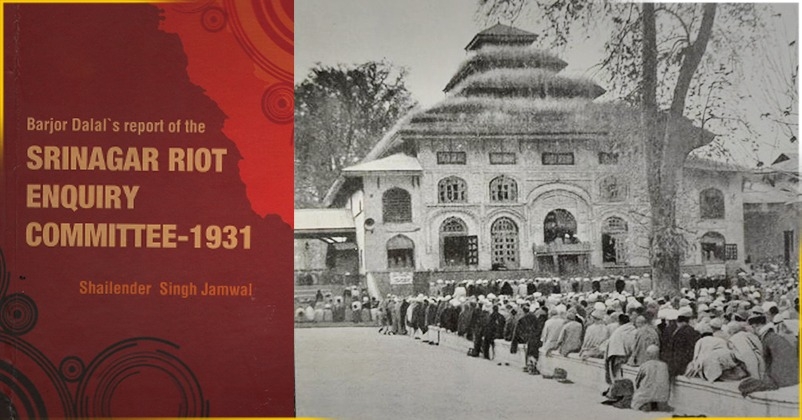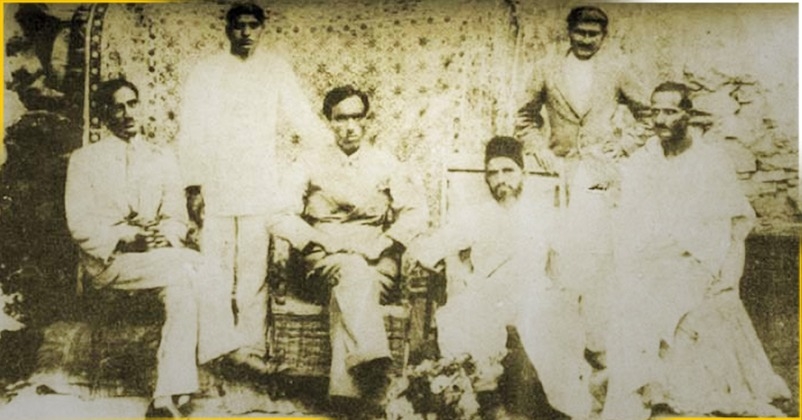13 July 1931, BLACK DAY,How many of us know the truth of Srinagar Communal Riots, Here are some LITTLE KNOWN FACTS
| 13-Jul-2019 |

-Y R Gupta
The government that claims to be secular and nationalist is observing the Black Day of 13th July as a Martyrs Day every year thus pouring salt on the wounds of the Hindu Community which suffered untold atrocities at the hands of the Muslims during this completely communal movement which later spread up to the farthest corner of the state that is Kotli and Mirpur and thus keeping this communal tension alive. The happening of that day is not likely to be taken as free form prejudice unless supported by authentic and impartial version available and leave the readers to form his own opinion, as to whether the persons who were killed as a result of the police/military firing during these communal disturbances, merited being officially declared as National Martyrs.
A British military officer helped one Abdul Qadir, a religious fanatic from Peshawar to enter Kashmir in the guise of his cook. He was an excellent speaker at a meeting at Khanqa-i-Mualla, he was invited to speak and he made a speech there of highly seditious and communal nature, quoting frequently from Quran in support of his inflammatory statements. He was naturally arrested and charged before the court. The crowds not only resisted the arrest and shouted objectionable slogans, but also threatened to obstruct the work of the court, which was then held within the premises of the Central Jail.
On the 13th of July 1931, the day fixed by the court for hearing of the case, communal disturbances of the worst type took place in Srinagar city and it suburbs resulting in the looting and burning of Hindu shops and houses on a large scale and the death of about 13 persons on account of police and military firing.
In their memory, the Governments that succeeded the Maharaja after Independence, and which claimed themselves to be secular and nationalist, are observing the black day of 13th of July as a National "Martyrs Day" every year thus perpetuating pin-pricking to the other community which suffered untold atrocities at the hands of the Muslims during this completely communal movement, and keeping the communal tension alive.

Sheikh Abdullah with Reading Room fellow leaders
Here is how Mr. G.S.Raghavan formerly Editor of the "Hindustan Times" the "Nation", the "Sunday Times", and other papers, described these happenings in Srinagar in his book "THE WARNING OF KASHMIR" published in 1931.
He says: "The hearing in Jail fell on 13th July. On that day, a mob stormed the Jail and demanded admittance along with the Sessions Judge. When the Judge had passed the gates, the crowd also attempted to get in. The other gates had been forced and the inner gates were attacked, AT the suggestion of the Judge, two muslim lawyers representing the accused, harangued the visitors to go out of the Jail precincts. Finding that there was no possibility of ingress, the crowd went out and started stoning officials and set fire to the police lines. The police force was then called in. All efforts to pacify the unruly mob proved futile. While there was commotion outside the Jail there was also disturbance inside, prisoners tried to force the iron gates. About this time, certain prisoners were being taken from the court to the Jail. The crowd stoned the policemen and the prisoners were liberated. The prospect was by no means satisfactory. The District Magistrate's order was defied, who had been summoned to the spot by the time, declared the crowd to be an "unlawful assembly" and ordered its dispersal. The order was defied and finding that the mob could neither be pacified nor dispersed, the District Magistrate directed fire to be opened. The crowd fell off but later it re-assembled and resumed stoning. It had to be dispersed with a Lathi charge. Part of the crowd, however moved towards the Hari Parbat Fort: the cavalry had to pursue it and disperse it again. A section of the recalcitrant's proceeded towards a place called Maharaj Ganj which is a business locality and loot over an extensive area followed. From Bhori Kadal to Ali Kadal a long stretch, the Hindu shops were raided. Other localities such as Safa Kadal, Ganji, Khad and Nawakadal too formed the centers of loot. Bazar streets were littered with property, books of accounts were burnt: the Hindu shopkeepers were molested, in short, pandemonium prevailed."
"The Hindu merchants lost lakhs worth of goods. Mr. Wakefield has affirmed that the articles were so strewn about the roads that his car would not pass, it is also his testimony that not a single Moham-medan complained to him about his premises having been invaded by the looters".
"The most extraordinary portion of the story was that almost simultaneously with the happenings at Srinagar, there was an uprising at a place named Vicharnag, some 5 or 6 miles away. It has been stated that untold atrocities were committed there; men owning lakhs were reduced to indigence and women were subjected to the worst possible and the most in decent assaults. A military force was despatched to the place, but by that time the havoc had been completed. Elsewhere, the Hindus were the victims of ambuscade. Some lost their lives and many suffered physical injuries. Stray assaults continued till long after".
Such is the origin of the "Martyr's Day" in Kashmir which is now being officially observed as a National Day by the "Secular" Government of the State.
Sheikh Mohammad Abdullah was among the guilty persons. He was arrested, convicted and sentenced, but was released before completing his sentence as a result of amnesty granted by the Maharaja in 1932. He then established the All Jammu and Kashmir Muslim Conference and became its first President.
The story of this "Black Day" will be incomplete without narrating the happenings in the Jammu province. This communal frenzy then spread to the far flung areas of Mirpur, Kotli, Rajouri and other parts of this area giving it a new name and created havoc. Hindu/Sikhs properties, homes were looted and burnt. Innocent people were mercilessly killed and many were converted to Islam forcibly. Religious places of worship of Hindus and Sikhs i.e. temples, Gurudwara's all met with same fate. Many were completely damaged and desecrated, in other few cases, though buildings were not damaged yet sacred God idols, religious books including Guru Granth Sahib badly damaged burnt and desecrated.
These happenings known as "88 NA SHAURASH" (Riots of 1988 Bikram or 1931 Christian Era) are still in the memory of not only survivals of that time but also of their subsequent generations, now Refugees of 1947 scattered throughout India & awaiting Rehabilitation.
Correspondence exchanged between different official agencies/Officers of the State Government and Indian (British) Government is preserved in the British Library in London. Only a few relevant reports out of the voluminous papers are being quoted here which are a proof in itself about the sufferings and atrocities suffered by the Hindu/Sikh community at the hands of Muslims.
Thirty One places of worship were completed destroyed and looted Cases of forced conversions, reported by the Admin Officer, are detailed below.
Teh :Rajouri-120, Seri-12, Bhimber-206, Kotli-224
(From Mr. Jardin Wazir Khazana, J&K
To Mr. R.L. Waltiner, Dy. Sect. Govt. of India)
Details of movable and unmovable properties has not been found, so far However it may be pointed out that the loss of non-muslim properties destroyed was very high.
(Ref. No. PB 238-DE Dated 30th June 1932 from Mr EJI Colin Prime Minister to Mr Latimer Resident in Kashmir)
Hindus of Sukkchainpur and Samwal (Mirpur) whose houses were completely damaged and burnt suffered most. Sukhchainpur has even taken the shape of a completely and deserted village.
Losses in Kotli Teh as compared to Mirpur Teh were much more. The central place of riots was Kotli Solahn village. Rioters were joined by the local wherever they went and with their help houses of Hindus/Sikhs were looted and burnt. Hindu villages Seri, Rajoa, Khui Rata and Dhana were almost completely destroyed or say fully raised to ground. Hindus properties were looted. Besides places of worships were completely destroyed. Even after the arrival of Army, certain places of worships though not destroyed yet God Idols and Guru Granth Sahib were desecrated in most in human manners. Despite presence of Army Main Bazar of Kotli which was central place of Tehsil had to face the same fate. This resulted in the migration of Hindus and Sikhs families to Mirpur, Bhimber and adjoining Punjab. (Ref: No. FM 467 Dt. 18/5/1932)
On 18th & 19th Jan 1932, a large number of Muslim crowd a Mob encircled Kotli city. However the attack failed in few hours as the attackers were in possession of old type of weapons and because of shortage of ammunitions. This attack took place before the houses and shops of Hindus were burnt in Chawla, Panjera, Kotli Sohlam, Seri and Khui Rata. Two Hindus were killed during this attack. (Ref. Kashmir Fight for Freedom by Justice Retd. Mohd Yousaf Saraf)
On 18thJan 1932, fifty villages were attacked in which 300 houses were looted out of which 70 were burnt. Though none was killed yet 40 Hindu/Sikh were converted forcibly to Islam. All these effected villages come under Rajouri Police station. It is an admitted fact that these communal riots were an extension of what happened in Kashmir.
Out of all these villages Thanna village and its bazaar suffered the highest loss. This took place on 20th Jan 1932. 36 Houses were looted out of which 8 were burnt. An other two villages where losses were heavy are Sohana and Sohani. In Sohana, 84 houses were looted and 4 houses were burnt whereas 31 houses were looted and 2 burnt in the other village. This happened on 28thJan 1932. In Bharot village, a very big house of Mohan Lal was looted and burnt. (Ref. DO Letter No. F-12C/32 Dated 29.03.1932 from Mr. C Latimer Resident in Kashmir). A Careful study of above happenings though not in full details, will reveal that this area suffered much more than what the valley suffered. It is unfortunate that the government of post 1947 Era have not done justice but declared 13th July as "Martyr Day" besides declaring the day as a Government Holiday.
Now is the time to give a healing touch to the sentiments of those who suffered at the hands of Muslim Fundamentalist which will be right step in this regard. Keeping in view the sentiments of not only valley Hindu community but also those belonging to the Mirpur, Kotli and Rajouri areas, withdrawing of the notification declaring 13th July as Holiday besides not celebrating this day (13th July) as Martyr's Day by the Government will be a step in the right direction to prove its secularism in true sense.